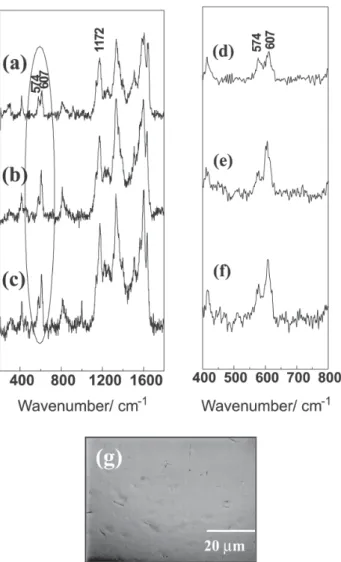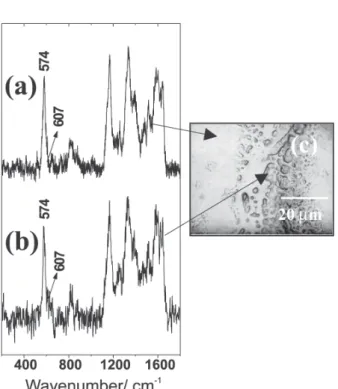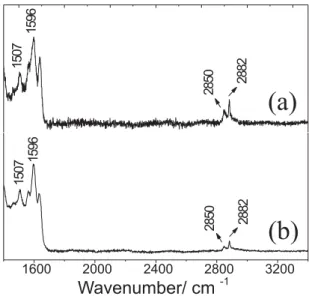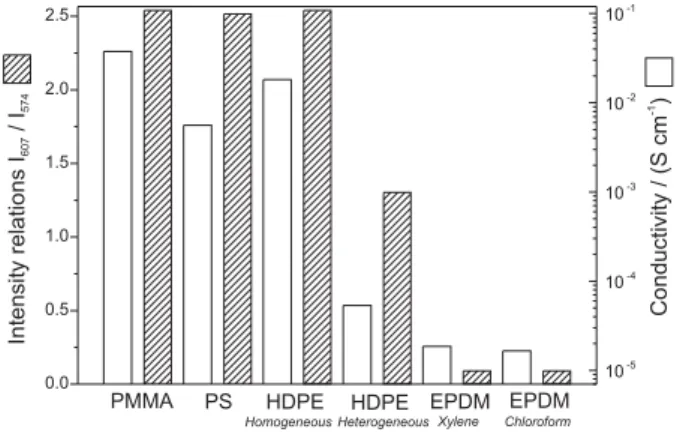0103 - 5053 $6.00+0.00
Article
* e-mail: storresi@iq.usp.br
Characterization of Conducting Polyaniline Blends by Resonance Raman Spectroscopy
José E. Pereira da Silva, Márcia L.A. Temperini and Susana I. Córdoba de Torresi
*Instituto de Química, Universidade de São Paulo, CP 26077, 05513-970 São Paulo - SP, Brazil
A microscopia óptica juntamente com a espectroscopia Raman no modo microscópico foram utilizadas para investigar as possíveis interações entre a polianilina (PANI) e diferentes polímeros isolantes em diversas blendas condutoras. Interações físicas podem ser inferidas através da análise das intensidades relativas das bandas em 574 e 607 cm-1. A condutividade do material e as intensidades
relativas destas bandas Raman são também analisadas.
Raman and optical microscopy were used to investigate possible interactions between polyaniline (PANI) and different insulating polymers in conducting blends. Resonance Raman and optical micrographs were used to study the physical interaction in materials. Analysis Raman spectra was done investigating the relative intensity of bands at 574 and 607 cm-1. A relationship between Raman
bands and conductivity was also proposed.
Keywords: Raman spectroscopy, optical microscopy, conducting blends, polyaniline
Introduction
Polyaniline (PANI) is an attractive conducting polymer due to its considerable conductivity, easy synthesis route and good thermal stability. The main disadvantage for industrial use is related to its powdered form, resulting in low processability and poor mechanical properties. A way of overcoming this problem is to prepare blends of PANI with insulating polymers to obtain suitable materials for being used in potential applications.
The mixture of two or more polymers to produce a blend or a composite is an efficient industrial strategy for achieving a material with specific properties. The goal of conducting blends is to combine mechanical properties of insulating polymers and electrical conductivity of conducting ones. These blends can be prepared by chemical (solution casting or melting) or electrochemical methods.
Conductive blends of PANI with poly(methyl methacrylate) (PMMA),1,2polystyrene (PS),3,4 polyethylene
(PE)5,6 and terpolymer ethylene-propylene-diene (EPDM)7
were obtained and a great number of practical applications proposed.8-10
Optical and electron microscopies are the most widely used techniques for the examination of polymeric blends morphology, but with the intrinsic limitation of providing
little information about the chemical composition of the phases. On the other hand, Raman spectroscopy used on the microscopic mode is an efficient tool for the characterization of interactions between polymers in the blends.11,12The main advantage of this technique is to
achieve information about chemical structure of the different domains in the sample due to high spatial resolution of the instruments (~ 1 Pm). Furthermore, it is also possible to obtain information about homogeneity without any previous preparation of the sample. The aim of this paper is to characterize PANI blends, prepared using different parameters (insulating polymers, solvents, temperature and dopants) by Raman spectroscopy and optical microscopy. Results were analyzed by considering chemical or physical interactions between the conductive material and the insulating matrix.
Experimental
PANI (Scheme 1) was chemically obtained via the oxidative polymerization of aniline (Scheme 2) by ammonium perssulfate in 1.0 mol L-1 HCl according to the
procedure described in the literature.13 The polymer
obtained was de-doped by placing it in a NH4OH solution and, after filtering, it was re-doped by dissolution in a 1 mol L-1 camphorsulfonic acid (HCSA) or 1 mol L-1
PANI-CSA and PMMA (Sheme 3) using m-cresol (Scheme 4) or CHCl3 as solvents. Solutions of 1, 5, 10 and 20% of PANI-CSA in PMMA were prepared. PANI-CSA/PS blends were obtained in the same way of PANI-CSA/PMMA ones, but in this case, the dissolution of PS (Scheme 5) is carried out in m-cresol heated at ca.1000C. After that, the mixture
with the conducting polymer was carried out at room temperature.
PANI-CSA/HDPE (high density polyethylene) blends were obtained by mixing heated solutions of PANI-CSA in m-cresol and HDPE (Scheme 6) in decalin (C10H18) (Scheme 7) in the same proportions, according to the literature.5 PANI-DBSA/EPDM blends were obtained by
mixing conducting and insulating polymers in xylene (Scheme 8) and CHCl3, respectively. In this case, the preparation of the blends involves the heating of EPDM solution in order to dissolve the polymer. The electrical conductivity of the films cast from different solutions was measured by standard four probe method using a Jandel Instrument.
Raman spectra for 632.8 nm exciting radiation (He-Ne laser, Spectra Physics, mod 127), were recorded on a Renishaw Raman Imaging Microscope (system 3000) containing an Olympus metallurgical microscope and a CCD detector. The laser power at the sample was kept below ~0.7 mW to avoid thermal degradation. The laser was focused using a 50x objective lens and spatial resolution was about 1 Pm.
Results and Discussion
Raman spectra of all blends prepared in this work, CSA/PMMA, CSA/PS, CSA/HDPE,
PANI-Scheme 1.
Scheme 2.
Scheme 3.
Scheme 4.
Scheme 5.
Scheme 6.
Scheme 7.
DBSA/EPDM (20/80% m/m) using Oo= 632.8 nm as the
exciting radiation, showed the predominance of bands corresponding to PANI in the doped state while bands related to the insulating polymers can be only observed in Raman spectra of blends containing less than 1% of conducting polymer. This fact occurs due to the resonance Raman effect,14,15 which increases the intensity of the bands
of the material when the incident radiation coincides with the frequency of an electronic transition of the sample. In these blends, only PANI absorbs in the visible range; so that, the intensities of PANI doped bands are enhanced compared to those of the insulating polymers.
Figure 1 shows resonance Raman spectra of: (a) pure PANI-CSA, (b) PANI-CSA/PMMA and (c) PANI-CSA/PS blends with 20% of conducting polymer. Figures 1(d), 1(e) and 1(f) show the enlargement of the same Raman spectra in the wavenumber range marked with a circle. It can be
seen that in the case of pure PANI-CSA/m-cresol, the bands at 574 and 607 cm-1 show the same relative intensities;16
while, in the blends, the band at 607 cm-1 is stronger than
the 574 cm-1 one. The latter band was assigned to the
formation of phenazine like structures produced by crosslinking among PANI-CSA chains (Sheme 9), and it has already seen that this band is strongly enhanced due to resonance phenomena in the red radiation.16 It was also
shown that changes in some experimental parameters such as temperature, solvents, Fenton’s reagents or oxidants in the synthesis of PANI, produce cross-linked PANI chains.16,17 The band at 607 cm-1 was assigned to the
benzene ring deformation (6a mode)18,19 and its increase of
intensity has already been observed in in-situ Raman spectra during electrochemical reduction swept.20The
decrease of the relative intensity of the band at 574 cm-1 in
blends spectra would indicate that a high amount of PMMA or PS within conducting polymer chains avoids the inter-chain interaction of PANI-CSA chains during preparation of the blend; furthermore, these changes are only observed for films that looks homogeneous upon optical microscopy observation, while the behavior for heterogeneous blends is quite different. Figure 1g shows the optical micrograph obtained for a PANI-CSA/PMMA (20/80% m/m) film, putting in evidence the high homogeneity of this material. Similar images were obtained for PANI-CSA/PS (20/80% m/m) blends. Raman spectra of these blends, taken in different regions of the films, do not show relevant changes in the relative intensity of both 607 and 574 cm-1 bands, in good agreement with the
homogeneous aspect of the films.
Figures 2a and 2b and Figures 3a and 3b show the Raman spectra obtained for PANI-DBSA/EPDM (20/80% m/m) blends prepared with chloroform or xylene respectively, obtained in different points of the samples. Optical micrographs (Figures 2c and 3c) show the heterogeneous aspect of these materials with agglomerates of conducting polymer in some regions. In all cases, independently on the region where the Raman spectra were taken, it is observed predominately a strong band at 574 cm-1 and a weak shoulder at 607 cm-1. The increase of the
Scheme 9.
micrographs of PANI-DBSA/EPDM blends are not observed in PANI-CSA/PMMA or PANI-CSA/PS ones, and Raman spectra of these latter materials showed the band at 574 cm-1 weaker than the band at 607 cm-1; thus, it would
be possible to do a direct correlation between the relative intensities of these bands and the homogeneity of the different blends studied.
Films of PANI-CSA/HDPE blends were obtained by two methods. In the first case, the preparation was performed by transferring an aliquot of a hot solution blend to a glass substrate by a Pasteur pipette. Raman spectra of this material in different points of the sample (Figures 4a and 4b) show that the relative intensity of the band at 574 cm-1 is stronger than that at 607 cm-1, indicating the
formation of a heterogeneous material, as in the case of PANI-CSA/EPDM blends. The fast solidification of HDPE avoids an intimate mixing between conducting and insulating phases when the hot solution blend was slowly transferred to the Pasteur pipette which was maintained at room temperature. In this way, the penetration of PANI in the insulating matrix is hindered. In agreement with Raman results, the optical micrograph (Figure 4c) shows a heterogeneous material with well localized regions with higher amount of PANI (black points) or higher amount of HDPE (white points).
In Figure 5, the Raman spectra of different regions of PANI-CSA/HDPE blends but in another range of wavenumbers, are presented. In this case it is possible to
Figure 2. Resonance Raman spectra (O0= 632.8 nm) of PANI-DBSA/ EPDM blend (20/80% m/m) prepared in CHCl3 of two different regions: (a) collected in a more homogeneous region and (b) col-lected in more heterogeneous region; (c) Optical micrograph indi-cating the acquisitions points.
Figure 3. Resonance Raman spectra (O0= 632.8 nm) of PANI-DBSA/ EPDM blend (20/80% m/m) prepared in xylene obtained in two different regions: (a) collected in a more homogeneous region and (b) collected in a dark region; (c) Optical micrograph indicating the acquisitions points.
relative intensity of the band at 574 cm-1indicates a high
amount of PANI crosslinked segments due to a higher inter-chain interaction.16,17Agglomerates shown in the
discuss the different compositions of the blend in different points of the sample. Figure 5a shows the Raman spectrum of the blend taken in the white points regions of the material; while, Figure 5b shows the Raman spectrum of the blend taken at black points. First of all, it is interesting to discuss the relative intensities of the bands of HDPE compared with PANI bands. Due to the already discussed Resonance Raman effect that enhances conducting polymer response, it is not possible to observe HDPE bands in the spectral region of characteristic PANI bands (200-1800 cm-1). However, the Raman spectra analysis of the
blend PANI-CSA/HDPE (20/80% m/m) in another wavenumber range, allows discussing some interesting points due to the presence of polyethylene C-H stretching bands in 2850 and 2882 cm-1. By comparing Figures 5a
and 5b, it can be seen that the relative intensities of these bands related to those of PANI located at 1507 and 1596 cm-1 and attributed to the N-H bending and C-C stretching
benzene rings,18,19 are very different depending on the
region of the blend; the relative intensity of HDPE bands being higher in the white points of the sample. On the other hand, black points show a lower relative intensity of HDPE bands and a better signal/noise relationship of the spectrum in agreement with higher amount of PANI in these regions that influences the intensification effect of the signal.
Different results were obtained when PANI-CSA/HDPE blends were prepared by fast transferring the hot mixture to a glass substrate. The Raman spectrum of the material (Figure 6a) shows the intensity of the band at 607 cm-1
being stronger than that of the 574 cm-1, indicating the
formation of a homogeneous material of PANI-CSA and HDPE. This fact can be corroborated in the optical micrograph of this blend that does not show phase separation (Figure 6b).
It was also observed a direct relationship between the homogeneity and conductivity of the materials, the conductivity being higher in homogenous than heterogeneous blends with the same amount of PANI-CSA in the insulating matrix Values closed to 10-1 S cm-1were
obtained for homogeneous CSA/PMMA and PANI-CSA/PS (20/80% m/m) blends; on the other hand, the conductivity observed for heterogeneous PANI-CSA/ EPDM (20/80% m/m) blends were of the order of 10-5 S
cm-1. Moreover, the value of conductivity obtained for
homogeneous PANI-CSA/HDPE was 10-1 S cm-1; while,
PANI-CSA/HDPE heterogeneous blends show low conductivity (10-3 S cm-1) as observed for heterogeneous
PANI-DBSA/EPDM blends. It is important to note that the values of conductivity obtained in this work are close to those found in the literature.1,21,22This is a very important
point because it would indicate that Raman spectroscopy would be used as a tool for indicating the conductivity of the material. Figure 7 shows a bar graph depicting the
Figure 6. (a) Resonance Raman spectra (O0= 632.8 nm) of PANI-CSA/HDPE (20/80% m/m) homogeneous blend and (b) optical micrograph.
relationship of band intensities I607/I574 for different PANI blends prepared in this work and the conductivity values. Typical I607/I574 values for homogenous blends are higher than 1.5; while, this value decreases to 0.3 for heterogeneous materials. It can be seen that this relationship is also directly related to the conductivity, as already discussed.
Conclusions
Raman and optical microscopy were used to investigate possible interactions between PANI and different insulating polymers. Physical interaction was inferred by analyzing the relative intensity of conducting polymer bands at 574 and 607cm-1 in Raman spectra. The intensity
of the band at 574 cm-1 is higher than that at 607 cm-1
when PANI interchain interaction occurs, for example in PANI-DBSA/EPDM blends; while the increase in the intensity of the band at 607 cm-1 indicates a more
homogeneous dispersion of conducting material in PMMA, PS and HDPE matrices in agreement with optical micrographs. A relation between Raman bands and conductivity was also proposed. In more homogeneous blends, linked with the increase of 607 cm-1 band, the
conductivities values were higher than heterogeneous ones, that are characterized with the increase of 574 cm-1
band.
Acknowledgements
Authors are indebted to Brazilian Agencies FAPESP (Proc. No 98/15686-3), CNPq and CAPES.
References
1. Cao, Y.; Smith, P.; MacDiarmid, A. G.; Synth. Met.1992,48, 91.
2. Yang, C. Y.; Cao, Y.; Smith, P.; Heeger, A. J.; Synth. Met.1993,
53, 293.
3. Jousseaume, V.; Morsli, M.; Bonnet, A.; Tesson, O.; Lefrant, S.; J. Appl. Polym. Sci.1998;67,1205.
4. Roichman, Y.; Titelman, G.I.; Silverstein, M.S.; Siegman, A.; Markis, M.; Synth Met.1999,98, 201.
5. Valenciano, G. R.; Job, A. E.; Mattoso, L. H. C.; Polymer
2000,41, 4757.
6. Yang, C. Y.; Heeger, A. J.; Cao, Y.; Polymer2000,41, 4113. 7. Faez, R.; Gazzoti, W. A.; De Paoli. M. -A.; Polymer1999,40,
5497.
8. Wessling, B.; Synth. Met.1998,93, 143.
9. Anand, J.; Palaniappan, S.; Sathyanarayana, D. N.; Prog. Polym. Sci.1998,23, 993.
10. Roth, S.; Graupner, W.; Synth. Met.1993, 57, 3623. 11. Tselios, C.; Bikiaris, D.; Maslis, V.; Panayiotou, C.; Polymer
1998,39, 6807.
12. Ward, Y.; Mi, Y.; Polymer1999, 40, 2465.
13. Chiang, J. C.; MacDiarmid, A. G.; Synth. Met.1986, 13, 193. 14. Harris, D. C.; Bertolucci, M. D.; Symmetry and Spectroscopy,
Dover Publications, INC: New York, 1989.
15. Sala, O.; Fundamentos da Espectroscopia Raman e no Infravermelho, Ed. Unesp: São Paulo, 1998.
16. Pereira da Silva, J. E.; de Faria, D. L. A.; de Torresi, S. I. C.; Temperini, M. L. A.; Macromolecules2000, 33, 3077. 17. Rodrigue, D.; Snauwaert P.; Demaret, X; Riga, J.; Verbist, J. J.;
Synth. Met.1991,41, 769.
18. Louarn, G.; Lapkowski, M.; Quillard, S.; Pron, A.; Buisson, J. P.; Lefrant, S.; J. Phys. Chem.1996,100, 6998.
19. Cochet, M.; Louarn, G.; Quillard, S.; Boyer, M. I.; Buisson, J. P.; Lefrant, S.; J. Raman Spectros.2000,31, 1029. 20. Pereira da Silva, J. E.; de Torresi, S. I. C.; Temperini, M. L. A.;
J. Braz. Chem. Soc.2000,11, 91.
21. Valenciano, G. R.; Job, A. E.; Mattoso, L. H. C.; Polymer
2000,41, 4757.
22. Faez, R.; De Paoli, M. -A.; Eur. Polym. J.2001,37, 1139.
Received: November 23, 2004
Published on the web: April 6, 2005
FAPESP helped in meeting the publication costs of this article. Figure 7. Bar graph of the relationship I607/I574 intensity bands and



